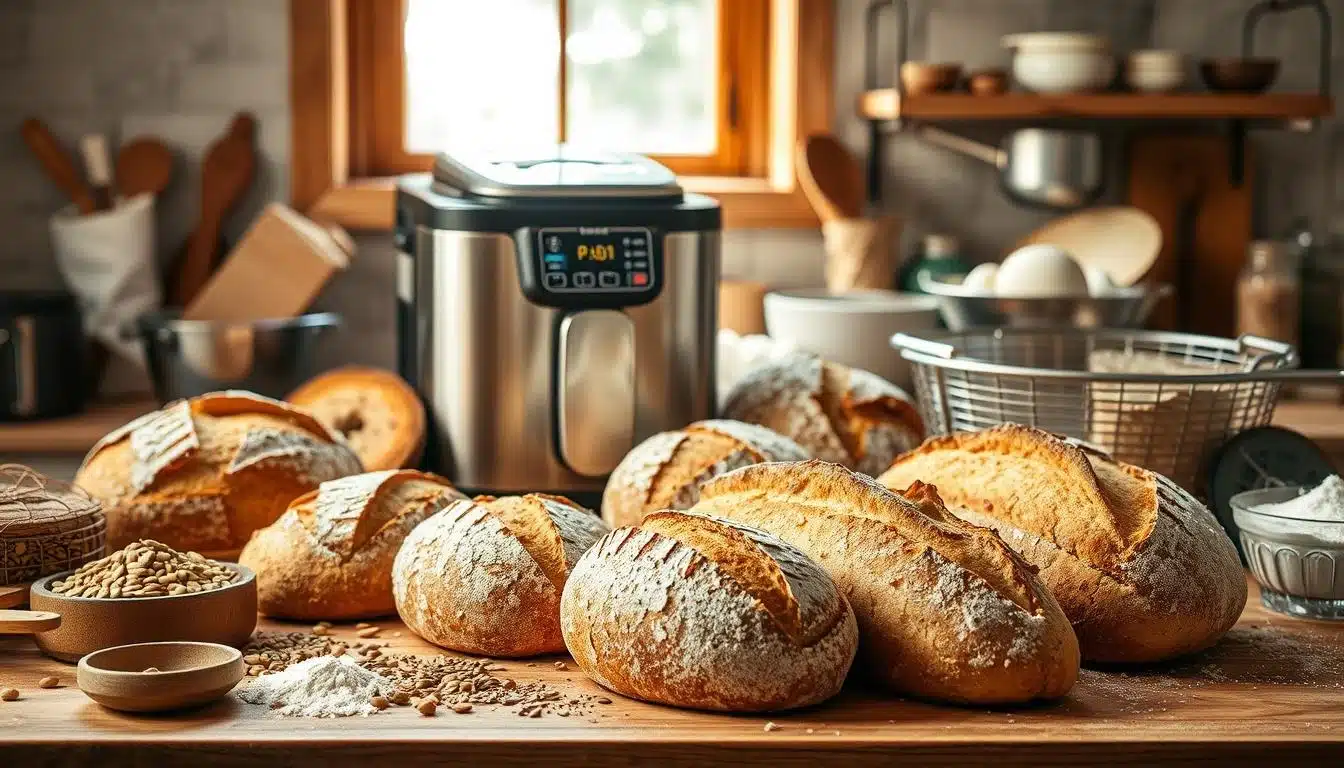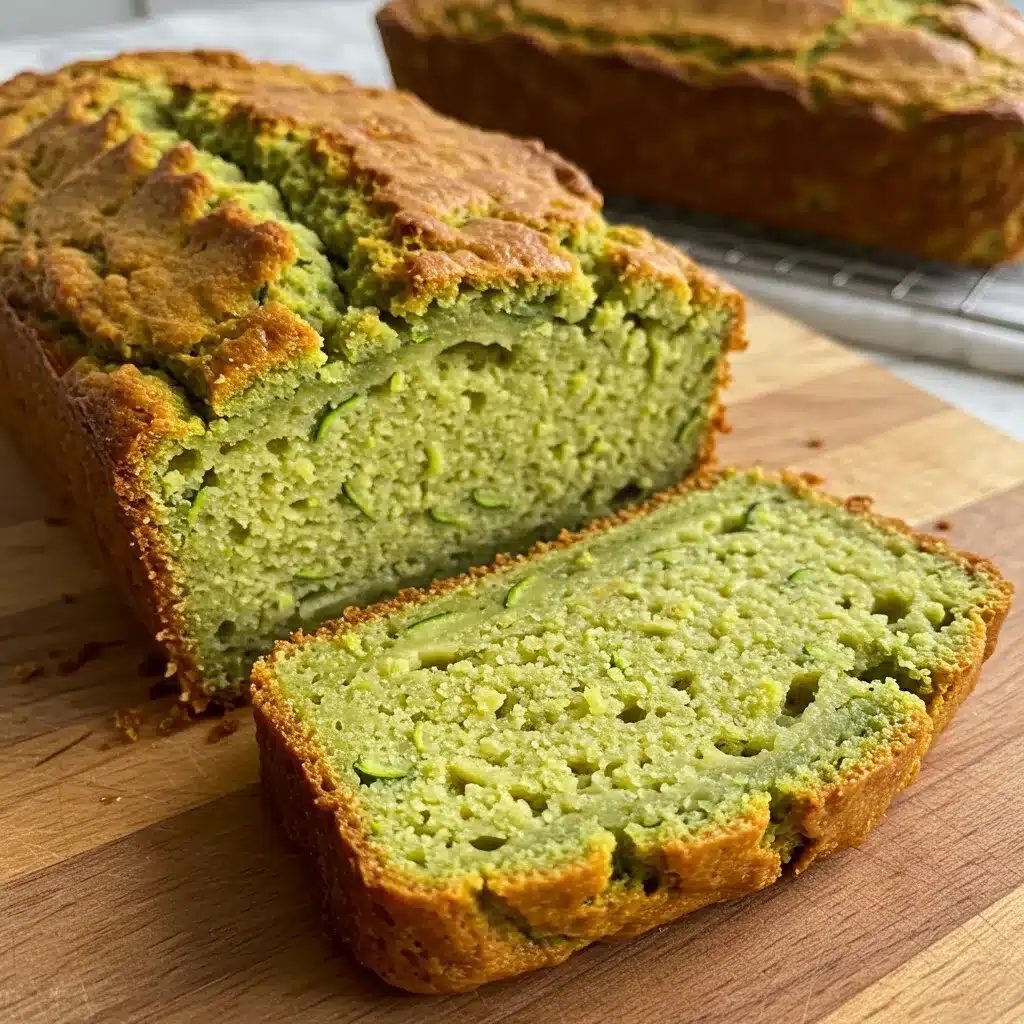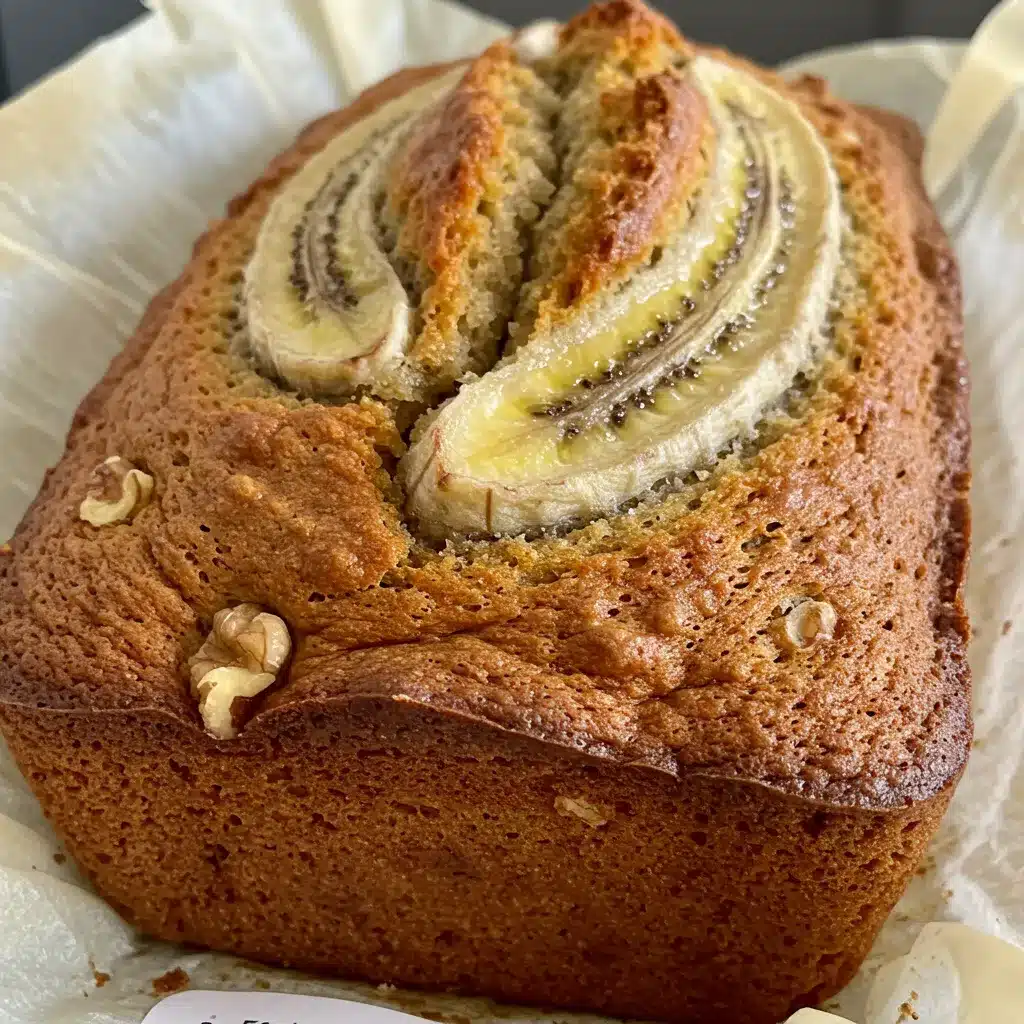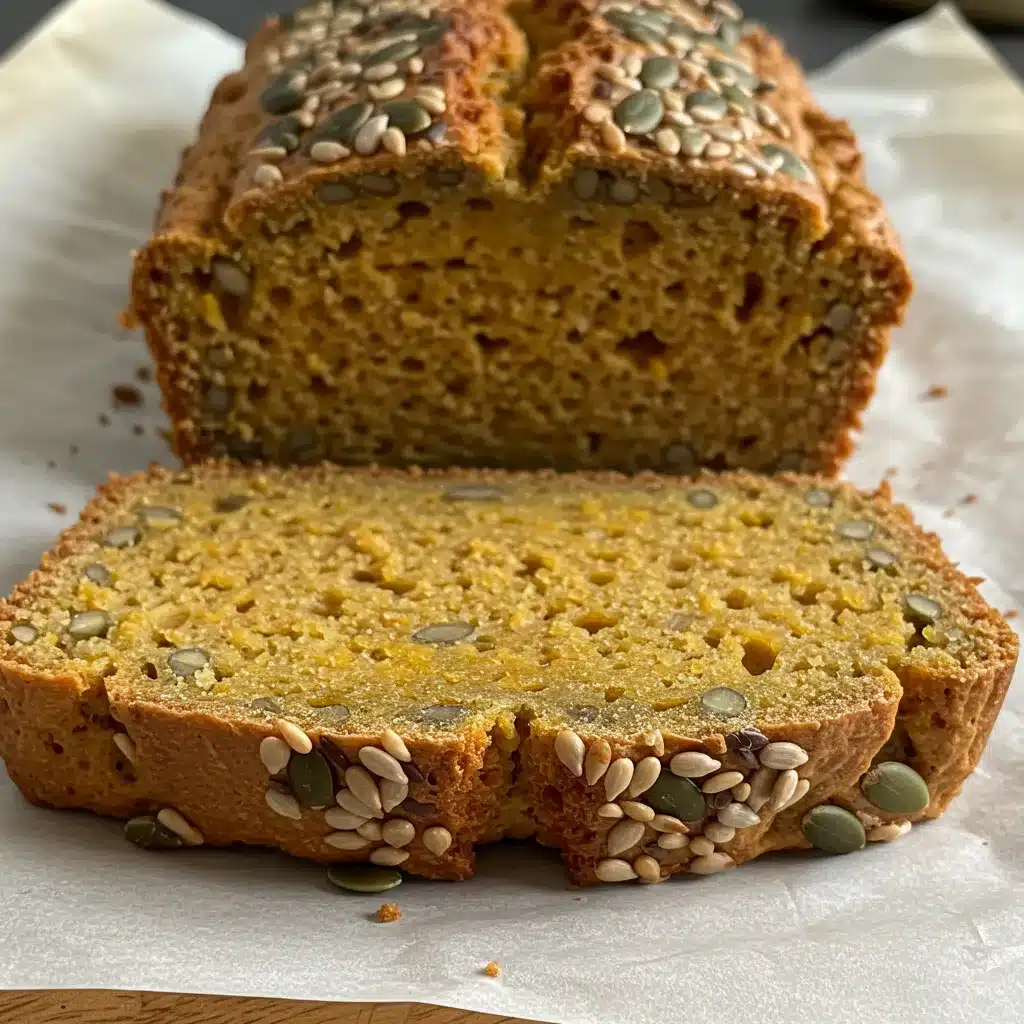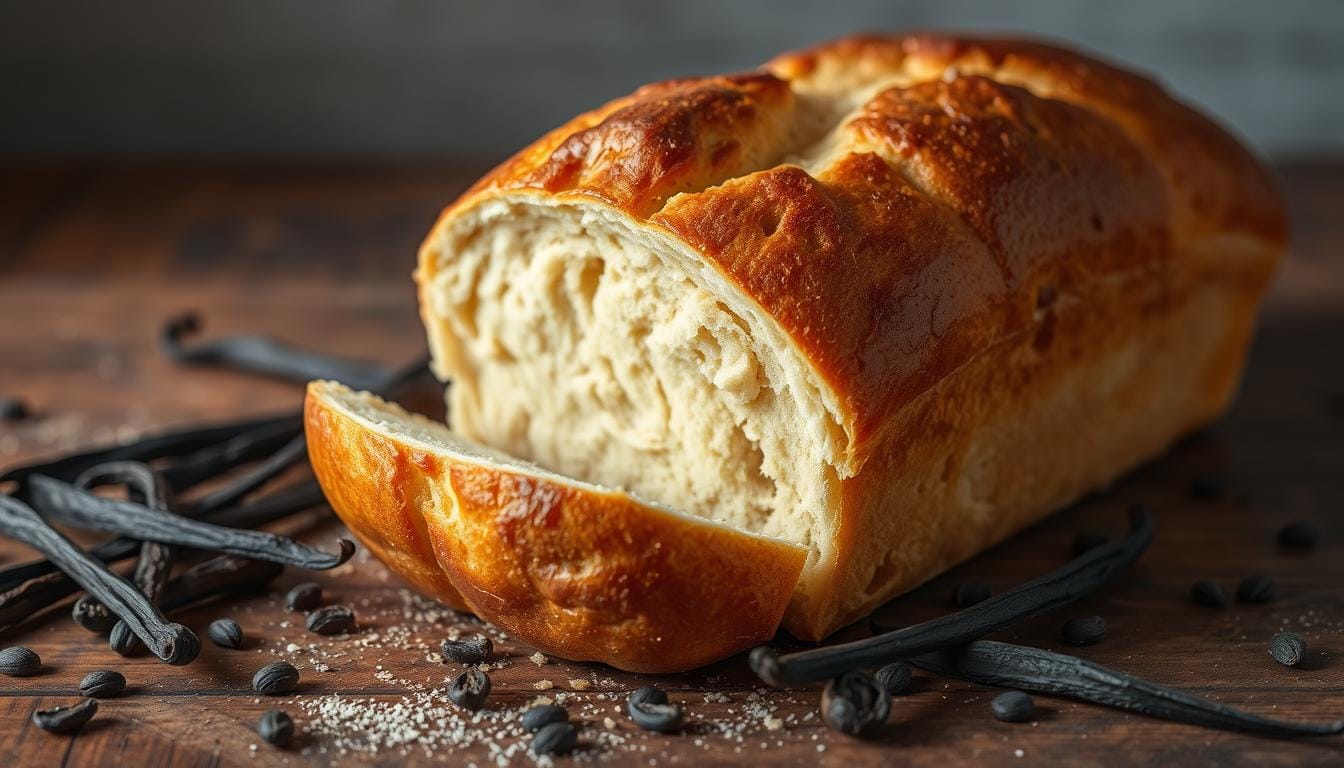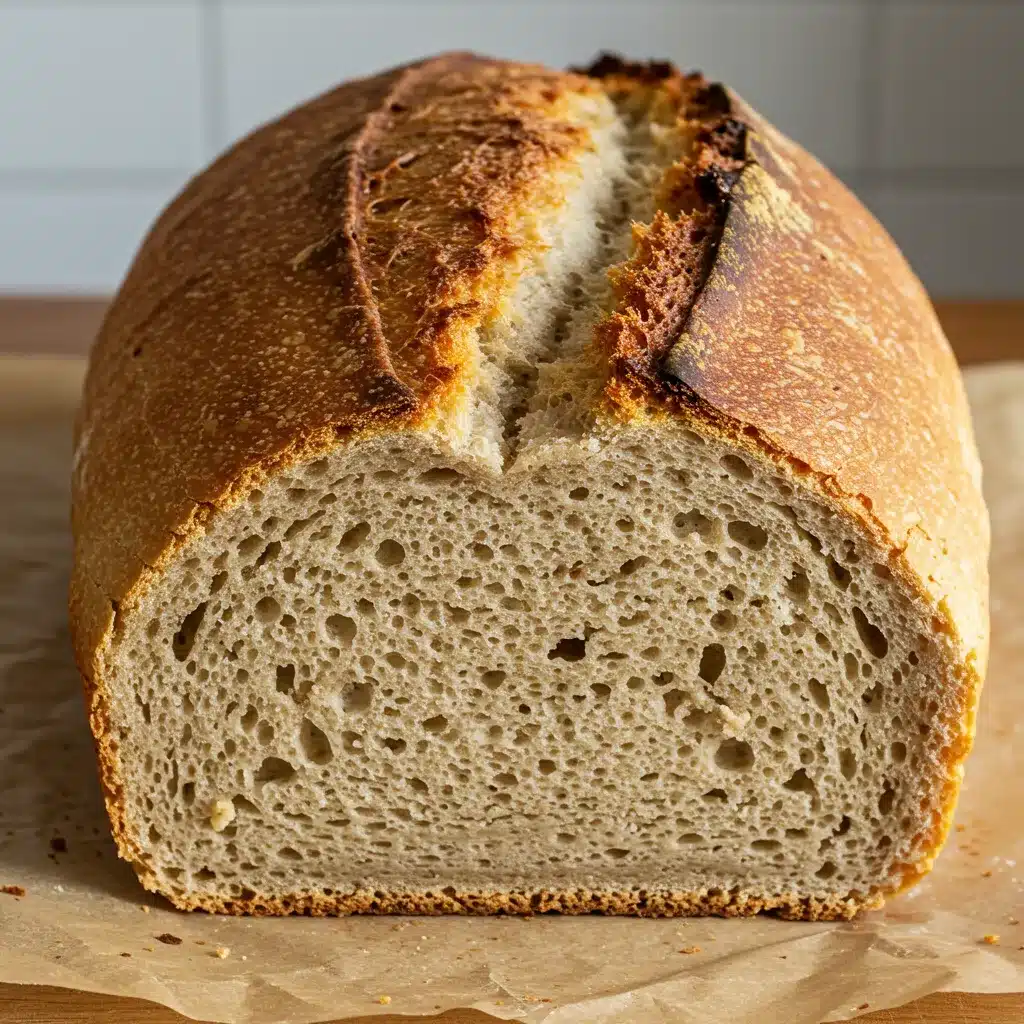Reka Bread Recipe
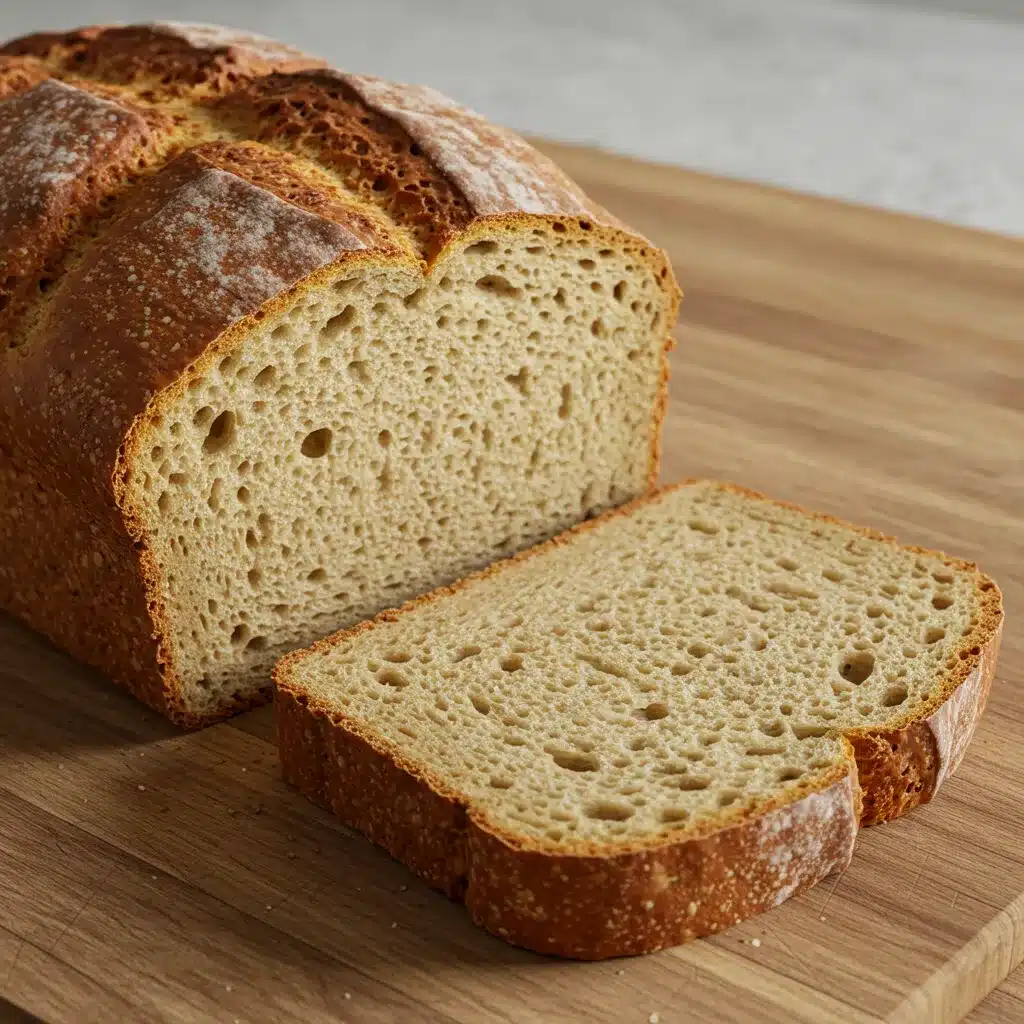
Did you know 75% of Americans love homemade bread more than store-bought? With the right reka bread recipe, you can join them. Making bread at home is simpler than you might think. This guide will help you make a delicious homemade loaf.
The reka bread recipe is a fantastic starting point. It offers a unique taste and texture that everyone will enjoy.
Exploring homemade bread, you’ll find that the right ingredients and techniques matter a lot. With a recipe like reka bread, you can make everything from classic sandwiches to hearty toast. This recipe is easy to follow, making it perfect for both new and experienced bakers. It promises a delicious bread that will become a favorite in your home.
Table of Contents
Introduction to Traditional Reka Bread
Exploring traditional breads, you’ll find traditional reka bread is loved by many. It comes from European baking, with a history spanning centuries. Each region has added its own twist to the recipe, making it rich and fascinating.
Traditional reka bread is special because it combines old-world techniques with modern touches. It’s perfect as a side to soups or as a sandwich base. It’s sure to impress anyone.
Origins and History
The story of reka bread is long and interesting, rooted in European baking. From France’s crusty breads to Germany’s hearty loaves, each place has its own version. Its rich history explains why it’s a favorite in many cultures.
What Makes Reka Bread Special
What makes traditional reka bread stand out? It’s the mix of traditional ingredients and modern methods. Every detail, from flour to kneading, is carefully thought out. This makes each loaf unique.
Traditional Uses and Serving Suggestions
Reka bread is versatile. Use it for sandwiches or as a side to soups and stews. You can even make croutons or bread crumbs for salads. Its rich history and origins make it a favorite among bread enthusiasts.
- Serving as a side to soups and stews
- Using as a base for sandwiches
- Making croutons or bread crumbs for salads
Traditional reka bread is a must-try for bread lovers. Whether you’re looking for a new recipe or want to learn about this bread, you’ll find it delightful.
Essential Ingredients for Your Reka Bread Recipe
To make delicious Reka bread, you need a few essential ingredients for bread. These include high-quality flour, yeast, salt, sugar, and water. The flour type greatly impacts the bread’s texture and taste. So, use bread flour with high protein for the best results.
Here are the reka bread ingredients you’ll need:
- 2 cups of bread flour
- 1 teaspoon of active dry yeast
- 1 teaspoon of salt
- 1 tablespoon of sugar
- 1 cup of warm water
You can also add olive oil, herbs, and spices for extra flavor. When picking your reka bread ingredients, choose high-quality and fresh items. This ensures the best taste and texture.

In summary, making great Reka bread requires quality essential ingredients for bread and a reliable recipe. With these reka bread ingredients and practice, you’ll soon be baking delicious Reka bread.
| Ingredient | Quantity |
|---|---|
| Bread flour | 2 cups |
| Active dry yeast | 1 teaspoon |
| Salt | 1 teaspoon |
| Sugar | 1 tablespoon |
| Warm water | 1 cup |
Required Kitchen Equipment and Tools
To bake your Reka bread, you’ll need some key kitchen equipment for bread. The right tools make the process smoother and more fun. They help you get better results and enjoy the baking more.
For bread making tools, you’ll need a few basics. You’ll need a big mixing bowl, a measuring cup, a wooden spoon, and a baking sheet. These tools help you mix, knead, and bake your bread easily.
There are also some optional kitchen equipment for bread that can improve your results. You might want a stand mixer with a dough hook, a bread machine, or a baking stone. These tools make mixing, kneading, and baking easier. They also help you get a professional-looking finish.
Here is a list of the equipment you’ll need:
- Large mixing bowl
- Measuring cup
- Wooden spoon
- Baking sheet
- Stand mixer with dough hook attachment (optional)
- Bread machine (optional)
- Baking stone (optional)
With the right bread making tools and equipment, you can make delicious Reka bread. It will impress your friends and family. Choose high-quality equipment that lasts long and makes baking more fun.
Preparing Your Workspace and Ingredients
For baking, a clean and organized workspace is key. Clear a big area on your counter for kneading and measuring. This keeps things tidy and makes the process smoother. Start by cleaning your countertops and getting all your baking tools ready, like a mixing bowl and measuring cups.
Accuracy is vital when preparing bread ingredients. Getting each ingredient right is crucial for the perfect texture and taste. Take your time to measure each ingredient carefully. Use only the freshest and best ingredients for the best results.
Here are some important steps for preparing your workspace and ingredients:
- Clear a large area on your counter for kneading and measuring ingredients
- Gather all necessary equipment, such as a mixing bowl and measuring cups
- Measure out ingredients accurately to ensure the best results
- Use fresh and high-quality ingredients for optimal flavor and texture
By following these steps and focusing on your workspace and ingredients, you’re on your way to making delicious homemade Reka bread. Stay focused and avoid distractions. This will help you get the perfect texture and consistency in your bread.
| Ingredient | Measurement |
|---|---|
| Flour | 2 cups |
| Yeast | 1 teaspoon |
| Salt | 1 teaspoon |
Step-by-Step Reka Bread Recipe
To bake reka bread, follow these simple steps. The recipe is easy for all bakers. Start by mixing flour, yeast, salt, sugar, and water in a certain order. This makes a shaggy dough that’s key for the bread’s texture and taste.
Next, knead the dough with pushing, pulling, and folding motions. This step makes the bread chewy. Then, let the dough rest and rise. This step is crucial for the bread’s full flavor and texture.
Making the Dough
First, mix 2 cups of flour, 1 teaspoon of yeast, 1 teaspoon of salt, 1 tablespoon of sugar, and 1 cup of water in a big bowl. Mix until a shaggy dough forms.
Kneading Techniques
Now, knead the dough. Use pushing, pulling, and folding motions for 10-15 minutes. The dough should become smooth and elastic.
Proofing Process
After kneading, let the dough rest and rise in a warm, draft-free area. It should take about 1 hour, or until it doubles in size.
Shaping the Loaf
Once proofed, gently deflate and shape the dough into a round or oblong loaf. Place it on a baking sheet lined with parchment paper.
Baking Instructions
Preheat your oven to 375°F (190°C). Bake the loaf for 35-40 minutes, or until it’s golden brown and hollow when tapped. Follow these steps to make a delicious homemade reka bread. Baking reka bread is fun and rewarding.
| Step | Description | Time |
|---|---|---|
| Making the Dough | Combine flour, yeast, salt, sugar, and water | 10 minutes |
| Kneading | Knead the dough using pushing, pulling, and folding motions | 10-15 minutes |
| Proofing | Allow the dough to rest and rise | 1 hour |
| Shaping the Loaf | Shape the dough into a round or oblong loaf | 10 minutes |
| Baking | Bake the loaf in a preheated oven | 35-40 minutes |
Understanding the Perfect Texture and Consistency
To get the perfect bread texture, knowing what affects it is key. The ideal perfect bread texture is soft inside and crispy outside. This comes from not overmixing, the right proofing time, and baking at the correct temperature.
For reka bread consistency, several things matter. These include flour type, yeast activity, and baking time. By knowing how these impact texture, you can tweak your recipe for the best results. Here are some tips for achieving the perfect texture and consistency:
- Choose the right flour: The flour type greatly influences bread texture. Try different flours to find your favorite.
- Avoid overmixing: Overmixing makes bread dense and tough. Mix just until combined, then let it rest.
- Proof correctly: The right proofing temperature and time are crucial for perfect texture.
By following these tips and understanding the factors that affect your reka bread’s texture and consistency, you can make your bread truly stand out. Achieve a perfect bread texture and reka bread consistency that will impress everyone.
| Factor | Affect on Texture |
|---|---|
| Flour type | Softness and airiness |
| Yeast activity | Rise and crumb structure |
| Baking time | Crust color and crispiness |
Common Mistakes to Avoid
When baking Reka bread, you might run into some common mistakes. These can make your loaf less than perfect. Issues like overmixing, underproofing, and wrong oven temperature are common problems.
These mistakes can lead to a dense or flat loaf. But, knowing these issues can help you avoid them. Adjusting how long you mix, proof, or bake can make your bread light and fluffy.
Dough Problems and Solutions
- Overmixing: Mix the dough just until the ingredients come together in a shaggy mass.
- Underproofing: Allow the dough to proof for the recommended time to ensure it rises properly.
- Incorrect yeast temperature: Make sure the yeast is at the correct temperature to activate it properly.
Baking Issues Fixed
To fix common baking issues, try adjusting the oven temperature or baking time. You might also want to use different flour or adjust the dough’s liquid. Troubleshooting these problems can help you make a delicious Reka bread.
Knowing these common mistakes and how to avoid them can help you make great Reka bread. Always follow the recipe closely and make adjustments as needed for the best results.
| Common Mistake | Solution |
|---|---|
| Overmixing | Mix the dough just until the ingredients come together |
| Underproofing | Allow the dough to proof for the recommended time |
| Incorrect oven temperature | Adjust the oven temperature to the recommended level |
Storage and Freshness Tips
After baking your Reka bread, it’s key to store it right to keep it fresh. Cool it down completely before putting it in an airtight container at room temperature. This stops moisture buildup and keeps the bread fresh longer.
Freezing your Reka bread is a great way to keep its texture and taste. Slice it first, then wrap it tightly in plastic wrap or aluminum foil. This lets you thaw and use only what you need, saving time and reducing waste.
Proper Storage Methods
- Store Reka bread in an airtight container at room temperature for up to 3 days.
- Freeze Reka bread for up to 2 months.
- When freezing, slice the bread before wrapping it to make it easier to thaw and use only what you need.
Freezing Instructions
To freeze Reka bread, just follow these easy steps:
- Cool the bread completely.
- Slice the bread into desired portions.
- Wrap each slice tightly in plastic wrap or aluminum foil.
- Place the wrapped slices in a freezer-safe bag or container.
By using these storage and freezing tips, you can enjoy your homemade Reka bread longer. Whether you store it at room temperature or freeze it, the goal is to keep it fresh and dry. These simple steps help you keep your Reka bread fresh and tasty, great for snacks, sandwiches, or with your favorite meals.
Variations of Traditional Reka Bread
Exploring reka bread, you’ll find many reka bread variations. These can make the traditional recipe your own. Try different herbs, spices, or flours to create unique tastes.
Adding nuts, seeds, or dried fruits to the dough is a great idea. These ingredients boost flavor and add texture. You can mix and match to find your favorite.
Here are some ideas to get you started:
- Garlic and rosemary: Infuse your reka bread with the savory flavors of garlic and rosemary for a delicious accompaniment to soups or stews.
- Dried cranberries and orange zest: Add a sweet and tangy twist to your reka bread by incorporating dried cranberries and orange zest.
- Sesame seeds and poppy seeds: Create a crunchy and nutty texture by topping your reka bread with sesame seeds and poppy seeds.
Remember, the key to mastering reka bread variations is to experiment and have fun. Don’t be afraid to try new ingredients and flavor combinations to create your signature reka bread recipe.
Serving Suggestions and Pairings
There are countless ways to serve reka bread. You can enjoy it alone or with various dishes to boost its taste and texture. Serving reka bread is an art that can make meals unforgettable.
Traditionally, reka bread goes well with soups, stews, or as sandwich bases. But, modern ideas have elevated this bread. You can use it for bruschetta, as a salad side, or as croutons in soups. The secret to great reka bread pairings is to match its rich, slightly sweet taste with the right ingredients.
Traditional Accompaniments
- Soups: creamy broths, stews, or chili
- Stews: beef, lamb, or vegetable-based
- Sandwiches: classic combinations like ham and cheese or turkey and avocado
Modern Serving Ideas
- Bruschetta: topped with fresh tomatoes, basil, and mozzarella cheese
- Salad accompaniment: croutons or crusty bread for a satisfying crunch
- Soup croutons: cubed reka bread toasted to perfection
Reka bread pairings can make any meal better, from casual get-togethers to special events. By trying out different serving ideas and pairings, you can find new favorite ways to enjoy this tasty bread.
| Reka Bread Pairing | Description |
|---|---|
| Grilled Cheese | A classic combination of melted cheese and reka bread |
| Tomato Soup | A comforting pairing of creamy soup and crusty reka bread |
Nutritional Information and Dietary Considerations
Understanding reka bread nutrition is key. This traditional bread is mostly carbs, with some protein and fat. It’s okay to eat it in moderation as part of a balanced diet. For those with special dietary needs, bread dietary considerations are important for making good choices.
A slice of reka bread has about 80-100 calories. It has 15-20 grams of carbs, 2-3 grams of protein, and 1-2 grams of fat. The exact numbers can change based on the recipe and ingredients. Here’s a quick look at what’s in a slice:
| Nutrient | Amount (per slice) |
|---|---|
| Calories | 80-100 |
| Carbohydrates | 15-20g |
| Protein | 2-3g |
| Fat | 1-2g |
For those who can’t have gluten, there are gluten-free reka bread options. These are made with gluten-free flours and ingredients. This way, people with dietary restrictions can still enjoy reka bread while keeping their bread dietary considerations in mind.
Conclusion
Making the traditional Reka bread at home is both fun and rewarding. By following this recipe, you can make a delicious loaf. It’s all about the details, from choosing the right ingredients to kneading and baking.
With practice and patience, you’ll get better at making Reka bread. Your bread will look great and taste amazing. Share your homemade bread with loved ones and feel proud of your baking skills.
Don’t be shy to try new things and show off your baking skills. This Reka bread recipe will help you master this tradition. You’ll add a special touch to your baking.
Frequently Asked Questions
Dave’s Killer Bread recipes typically use whole grains, seeds, and organic ingredients, making them nutritious and delicious.
Yes, these recipes are compatible with most bread makers, but always refer to your bread maker’s manual for specific settings.
Dave’s Killer Bread recipes typically use whole grains, seeds, and organic ingredients, making them nutritious and delicious.
Yes, these recipes are compatible with most bread makers, but always refer to your bread maker’s manual for specific settings.
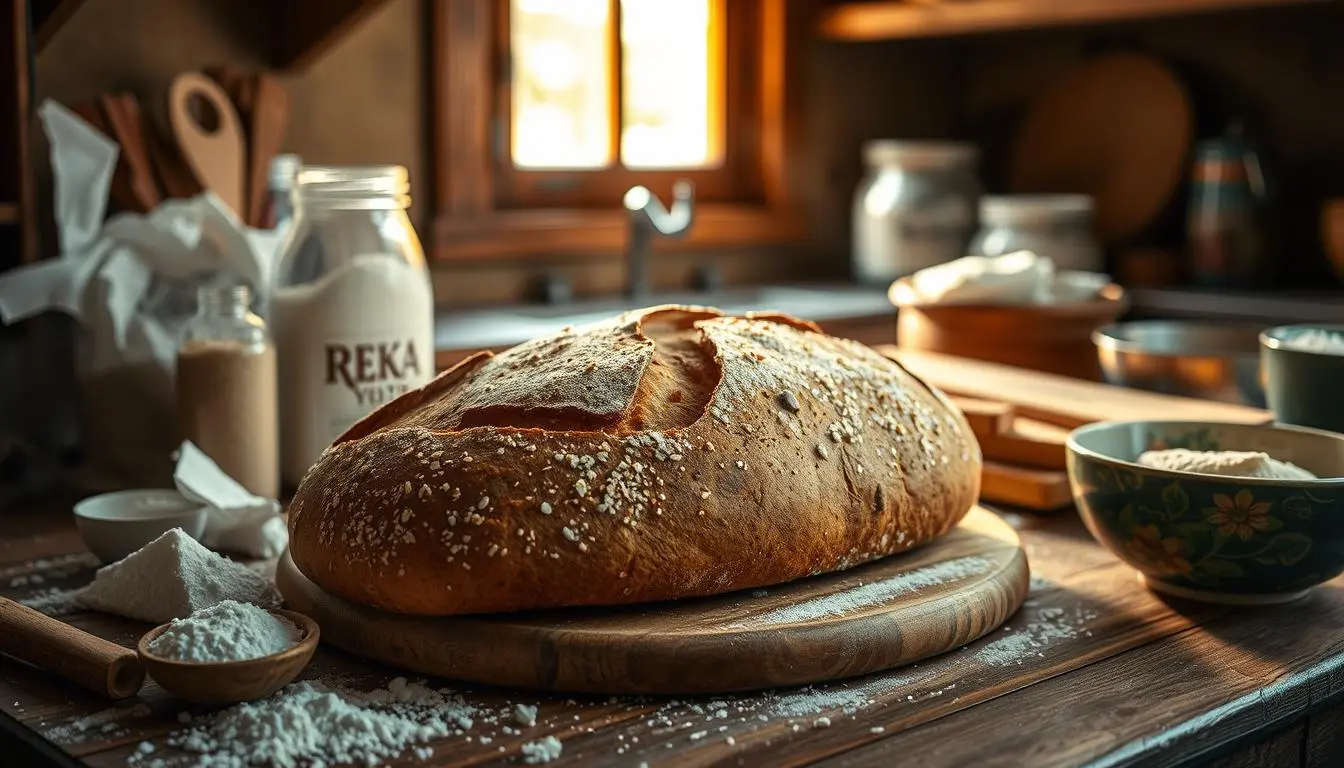
Reka Bread Recipe
Ingredients
- 3 cups all-purpose flour
- 1 tbsp sugar
- 2 tsp salt
- 2 1/4 tsp active dry yeast 1 packet
- 1 cup warm water
- 2 tbsp olive oil
Instructions
- In a bowl, mix warm water, sugar, and yeast. Let it sit for 5 minutes until frothy.
- Add flour, salt, and olive oil. Mix and knead until a smooth dough forms.
- Cover the dough and let it rise for 1 hour in a warm place.
- Punch down the dough, shape it, and place it in a greased loaf pan. Let it rise for 30 minutes.
- Preheat oven to 375°F (190°C) and bake for 25-30 minutes until golden brown.
- Cool before slicing and serving.
Notes
- For a softer crust, brush with butter after baking.
- Add seeds or herbs to the dough for extra flavor.
Nutrition
Have you tried this recipe?
Cooking made joyful with Perky Recipes

